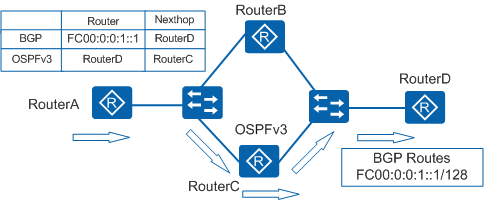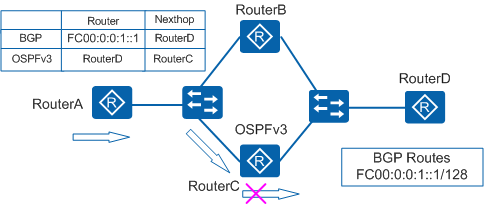OSPFv3-BGP Synchronization
When a router is restarted or a new router is deployed on a network, network traffic may be lost during Border Gateway Protocol (BGP) convergence. This is because IGP convergence is faster than BGP convergence. OSPFv3-BGP synchronization can solve this problem.
When a router on a BGP network recovers from a fault, BGP convergence is performed again. Packets may be lost during the convergence.
Figure 1 shows traffic traversing a BGP network, passing through Router C from RouterA to RouterD.
If a fault occurs on RouterC, traffic is redirected to RouterB after rerouting. Packets are lost when RouterC is restored to normal operating status.
This is because OSPFv3 convergence is already complete when RouterC recovers, and RouterC becomes the next hop on the route from RouterA to RouterD. However, at this point, BGP convergence on RouterC is not complete, so RouterC does not yet know the route to RouterD.
For this reason, when packets destined for RouterD are transmitted from RouterA to RouterC, they are discarded by RouterC because it has no route to RouterD. This is shown in Figure 2.
Process of OSPFv3-BGP synchronization
When a router enabled with OSPFv3-BGP synchronization restarts, it advertises a message in the local OSPFv3 area instructing other routers not to use it as a transit router.
At the same time, the router sets the cost value in its LSAs to 65535, the largest value. This ensures that it is not used by other routers as a transit router. The BGP route, however, can still reach the router.

